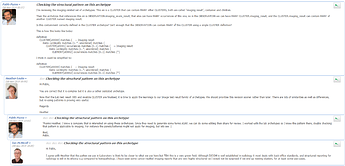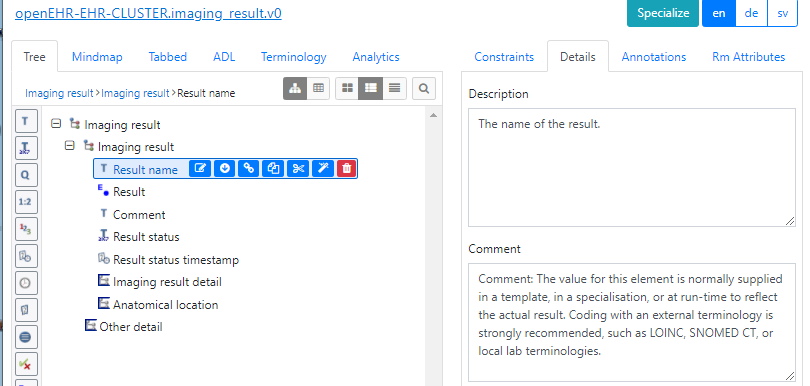HI!
We are developing a template for echocardiography in Sweden and have had a close look at a template from the German HiGHmed project, see: https://ckm.highmed.org/ckm/templates/1246.169.85 (Ping @birger.haarbrandt)
In HiGHmed’s template the archetype openEHR-EHR-CLUSTER.imaging_result.v0 is repeated in a nested fashion with an instance for each measurement type. All these are wrapped inside an openEHR-EHR-OBSERVATION.imaging_exam_result.v0 archetype.
We find most of the datapoints needed for our very similar Swedish use case, but to us it looks like the meaning/semantics of each nested measurement in HiGHmed’s template is only carried in the (native language specific) renaming name of the CLUSTER.imaging_result.v0 archetype in the surrounding template. (Or have we misunderstood something???)
See snippet from https://ckm.highmed.org/ckm/templates/1246.169.85 (click to enlarge)
Potential problems:
- It is hard (impossible with current archetype?) to, at the template level, encode each of the measurements with e.g. SNOMED CT or LOINC codes…
- …which in turn only leaves the language dependent labels as an option to discern between the values in AQL queries etc.
One (bad) solution would of course be to create a specialized CLUSTER archetype for each of the measurements within an echocardiography. But (just as with lab values) I suspect this would lead to very many little archetypes to maintain. AQL paths for each speacilized archetype would be easy to discern using the archetype name.
Another (somewhat bad) solution would be to create a larger completely new CLUSTER archetype containing many measurements at once. That would be less of a maintenance nightmare and easy to translate between languages etc. AQL paths for each branch within that big CLUSTER would be easy to discern (using the at/id-codes).
A third (probably better) solution/question:
Can we reuse the design pattern from e.g. openEHR-EHR-CLUSTER.laboratory_test_analyte.v1 where the field “Analyte name” allows e.g. a coded text that can be used for including e.g. SNOMED CT or LOINC codes at the template level and thus also in the AQL-queryable stored EHR data. See e.g. the glucose example by @siljelb in https://ckm.openehr.org/ckm/templates/1013.26.383
Something along the third alternative seems to have been discussed by @pablo. @heather.leslie and @ian.mcnicoll in https://ckm.openehr.org/ckm/archetypes/1013.1.2764/discussion (requires logging in to the CKM) - see relevant snippet as image below (click to enlarge)
By adding something like “Result name” (similar to the “Analyte name” pattern in labs) the archetype could become something like below
Image above: Screenshot of our local test modification with “Result Name” added to the CKM version
Text to cut&paste for the editor that wants to add the field in the archetype in the CKM follows…
Label: Result name
Description: Name of the result.
Comment: The value for this element is normally supplied in a template, in a specialisation, or at run-time to reflect the actual result. Coding with an external terminology is strongly recommended, such as LOINC, SNOMED CT, or local terminologies.



 but they don’t give me confidence to develop potential patterns. I also have access to a dataset for CT coronary angiography but it’s very specialised and I’d like to see more examples of CT reports in varying levels of detail.
but they don’t give me confidence to develop potential patterns. I also have access to a dataset for CT coronary angiography but it’s very specialised and I’d like to see more examples of CT reports in varying levels of detail.